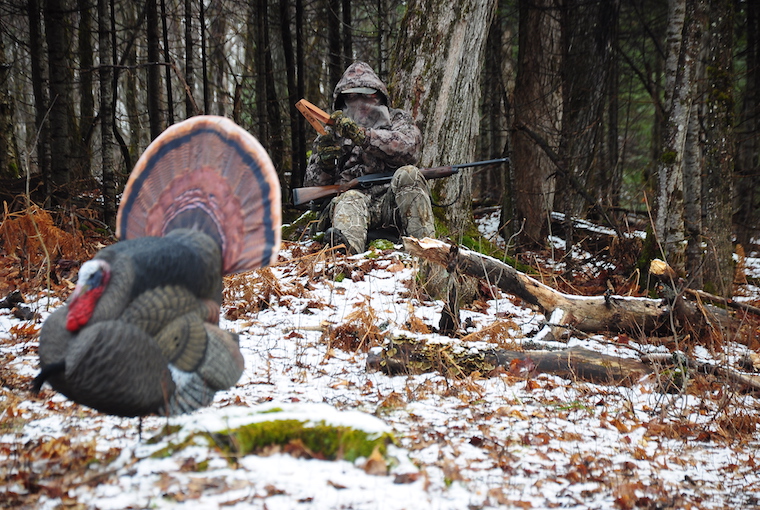
Turkey hunting myths arise because we see wild turkeys do the same thing several times and then assume they will always do it that way. But wild turkeys are unpredictable and break their own rules whenever they please. So, ditch the myths about turkey behaviour and be unpredictable yourself when you hunt them.
Turkeys become call shy
When it seems like every gobbler in the woods has its beak frozen shut and no amount of calling will get a response, hunters say the toms are call shy. But wild turkeys rely on their vocalizations every day to call their young, to find flock mates after being separated, to find each other for mating and to sort out their social rank. So turkeys can’t become call shy.
But they do become shy of hunter intrusion into their world. Heavily pressured toms hear the hunter enter the woods and start hen yelping. They get yelped at a lot and soon have the hunters patterned, then lock their beaks and move off. A savvy hunter will break the pattern by approaching from where he is not expected, even if it’s the long way around, and then call with kee kee runs and tom yelps rather than hen yelping.
You can’t call turkeys downhill
This myth arises from the fact that spring toms like to get on top of a hill or ridge to gobble and strut to attract hens. Many toms prefer that hens to come to them so it’s hard to call them away from a lofty strut zone with a commanding view of anything that approaches. But toms can go uphill, downhill or side hill whenever it suits them. Three tactics that have worked for me to call toms downhill are going silent, moving away slowly while calling softly and inciting jealousy with tom yelps.
Spring toms only come to hen calls
Yes, hens and toms are looking for each other in the spring and the hen call is an important spring call, but toms spend eight months of the year in bachelor groups with other toms. So, even in the spring, toms like the company of other toms once they sort out their social rank. Plus they are curious about new toms in their territory. So calling with tom yelps and tom clucks can bring in toms that want company or to establish their dominance over the newcomer.
You can’t call a tom away from hens
Real hens are your toughest completion in when it comes to calling in a spring tom. But sometimes a subordinate tom that is getting tired of seeing his boss bubby get all the hens will sneak away to another hen he hears calling. Also, dominant toms like to fight as much as they like to mate and may leave hens to investigate a challenger’s gobbles calls or excited tom clucks and yelps.
Turkeys won’t cross roads, fences, or creeks
When a spring tom is seen strutting back and forth along a fence, it looks like he is trying to find an opening to get through the fence, as though he doesn’t know he has wings to fly over it. Behaviour like that gave rise to the myth that toms won’t cross barriers. But it’s more likely the fence line is his strut zone where he expects to meet hens, and he likes having the fence there as a barrier to predators on one side.
Wild turkey habitat in Ontario is a patchwork of field and forest divided by roads, fences and creeks. If turkeys didn’t cross them daily they couldn’t survive.
You must be an expert caller to call in a tom
There are roughly seven or eight thousand turkeys harvested in Ontario each year. But, there aren’t that many expert callers. So you don’t have to be expert to succeed.
By all means, learn all you can about the language of the wild turkey and practice to make authentic calls. It’s a skill that you can always expand and perfect on a variety of types of calls. But a beginner with a push pin yelper can make acceptable yelps and clucks and call in his first tom or jake. I know because that’s how I got started.
You can’t call back spooked turkeys
I have heard it said if you bump turkeys while hiking in or call in and miss your shot at a tom, that’s it for the day in those turkey woods. But turkeys couldn’t survive if they had to remain on hyper alert all day every time they got spooked. Usually within a half hour they get back to normal turkey behaviour like finding food and mates.
If you do spook a tom, separate yourself from the incident by letting him walk off. Then, after half an hour, quietly move to a new setup several hundred yards away and set up to call again. Use a different call this time. Often they don’t know what spooked them and won’t connect it with a different call from a different location.
You need a fully tricked out turkey gun
Dedicated turkey shot guns keep improving with tighter chokes, better triggers, thumb hole or pistol grip stocks and optical sights. All these refinements help accuracy because a turkey gun is aimed like a rifle.
But keep in mind, our forefathers foolishly wiped out the wild turkey in Ontario with unregulated hunting using just basic fowling shot guns and open sight rifles. So if all you have is your water fowling shotgun you can still get in the game. Any full choke produces a lethal pattern for turkeys out to thirty yards with a good turkey shell.
If your gun doesn’t have a full choke, Hornady’s Heavy Magnum turkey shot shell, with the choke in the shell itself, is designed for lightly choked shotguns. It produces lethal patterns out to thirty yards out of modified or improved cylinder chokes. Just don’t try long shots. Set up in the woods rather than the fields and call them in close.
Toms only gobble in the spring
While Toms gobble a lot in the spring and most people only hear them in the spring, toms gobble whenever they want to express dominance, which is a year-round issue with toms. They also gobble to locate each other if they become separated from their bachelor group at any time during the year.
Wild turkey is dark meat and gamey to eat
I hear this often from folks who are projecting a bad experience with some poorly prepared game dish onto the wild turkey. Wild turkeys are the ancestors of domestic turkey so the wild turkey has white breast meat and dark leg meat also. But, the wild bird is the ultimate free range turkey with a wonderful flavour and much less fat.
If your wild turkey is tough and dry you are overcooking it. They are not self-basting supermarket birds injected with fat and salt to keep them moist, so only roast them until they reach 165 degrees F. then remove them from the oven for a moist and tender dinner. Roast them longer and you are making jerky.
Wild turkeys make a living on their legs so their legs are tougher but they have excellent flavour and make wonderful turkey soups and casseroles along with the scraps from a roasted bird.


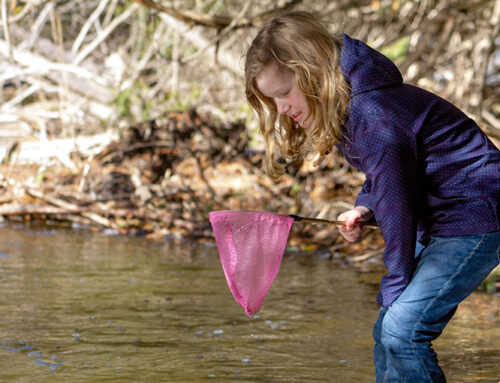
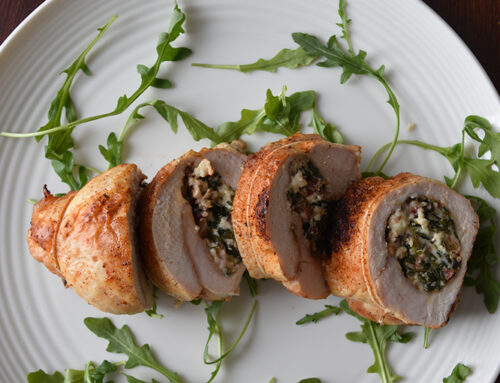
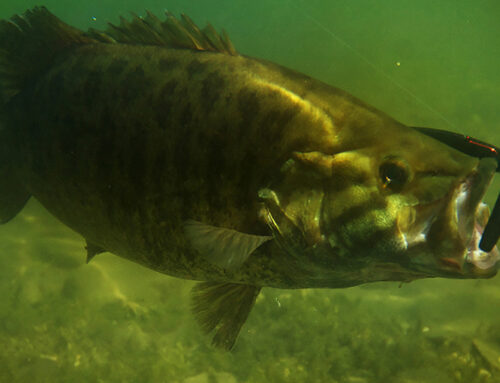
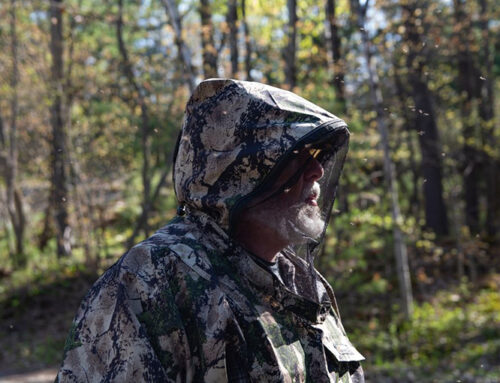
better still-breast the bird and cook them in a slowcooker with a can of cream of mushroom,brocoli or celery soup.rest of the bird the same and use the carcass for soup.no rule says they must be roasted.
Your Nov issue on drones was very enlightening. However, my observations were:
1) I see a double standard being applied somewhat where fish finders/boats are allowed to locate fish but drones are not allowed to locate prey. I suppose if we compare apples to apples, if we were on quad 4×4 with thermal sensors, it would similar to fishing.
2) The fact that there is no set guideline when a hunt can begin after flying a drone opens up the hunter for lots of legal challenges.
3) I highly doubt flying a drone a day before will guarantee success since the hunter will still have to traverse to the spot and setup. It’s not as easy as one might think.
3) According to the rules if a drone is flew the day before to locate the X on a large field, then the hunter is breaking the law.
4) I agree that drone should not be use while actively hunting (big game) but the rest of the other stuff should be relax.
Finally, can you add one more myth buster about turkey hunting. Please clarify that turkey hunting from a tree stands is or isn’t legal. The regulations doesn’t mention anything against it but there are confusing comments on facebook that they either are/are not allowed. I have been in tree stands many times during deer season where turkeys are walking right below the stands, much closer than a deer. I don’t think they would be harder to hunt in the spring from a deer stand.
Thank you for that suggestion. It sounds delicious. Wild turkey breast is versatile and can also be cubed battered and fried into nuggets. The only rule is not to overcook it and dry it out.
It would not be illegal to hunt turkeys during an open season from a tree stand. Some advantages I can see are that calling would reach out farther, you might hear a response better and a tom could be seen sooner when it comes in. But turkeys can pinpoint sound precisely and may see the hunter up the tree more easily than sitting on the ground. An option might be to call from the stand and climb down to set up on the ground if you hear a distant gobble in response.